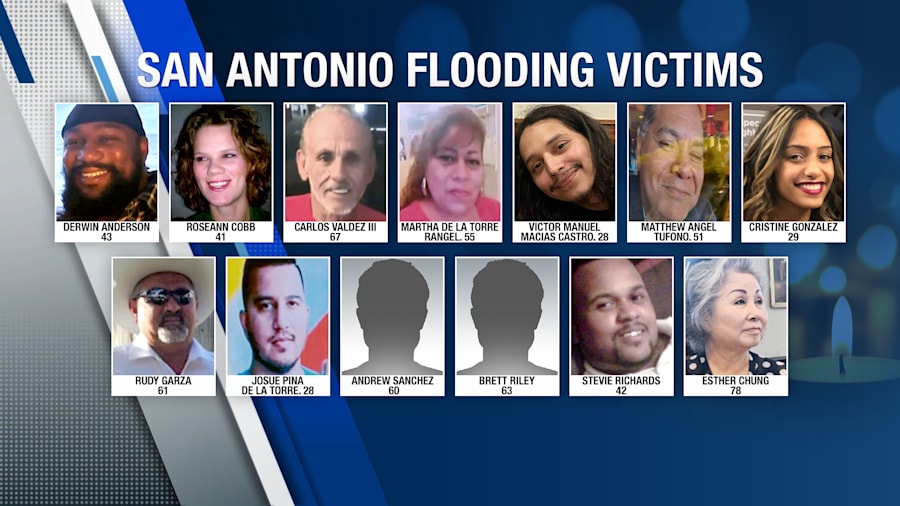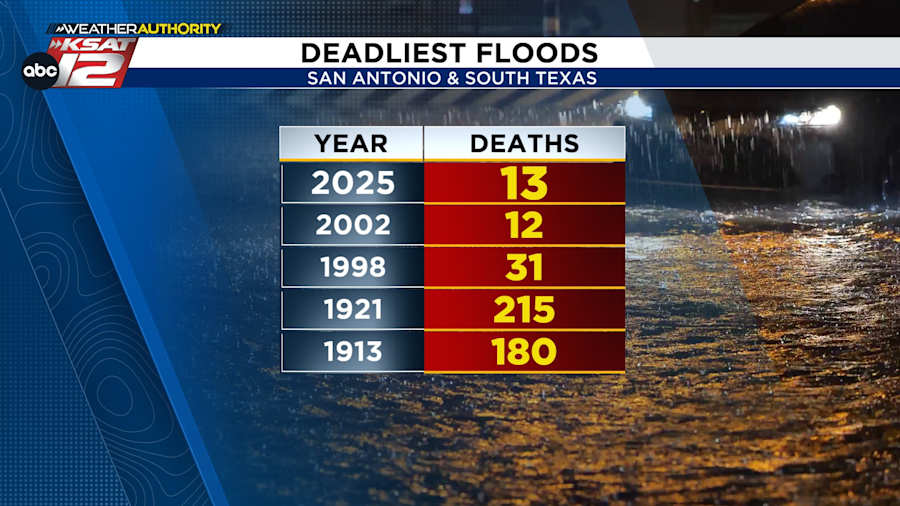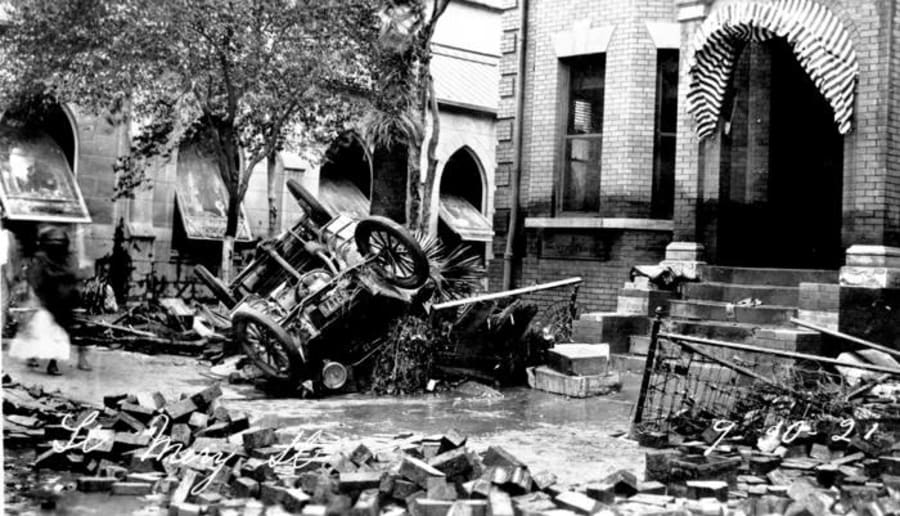SAN ANTONIO – San Antonio experienced severe storms and flooding that led to the loss of 13 lives last Thursday, June 12.
>> Remembering the victims of the June 12 floods in San Antonio
Recommended Videos
Here is everything we know about the deadly flooding and all the developments that have happened since that night.
Historic storms
The city measured 6.37 inches of rain, the highest daily rainfall since May 25, 2013, and the 10th rainiest day of all time.
High water flooding occurred on the lower level of Interstate 35, near Austin Highway and many other roads throughout the city.
San Antonio police and firefighters began receiving calls around 4:15 a.m. on Thursday for people stranded on the frontage road of Loop 410 near Perrin Beitel Road.
High water caused 15 vehicles to be swept away from the access road into a nearby creek, according to the San Antonio Fire Department.
Ten people were rescued from trees and bushes as far as one mile from where they entered the water, according to SAFD.
San Antonio fire crews responded to more than 200 weather-related calls, 70 water rescues and 24 major crashes overnight Wednesday, June 11 and into Thursday, June 12.
According to CPS Energy, around 30,000 people were affected by power outages during the peak of the storms.
13 people confirmed dead
Thirteen people have been confirmed dead from the flooding, according to the San Antonio Fire Department and the Bexar County Medical Examiner’s Office.
Eleven bodies were found in the Perrin Beitel search area, one body was found several miles upstream from the search area and one was found in the Highway 90 Leon Creek area, SAFD said.
On Friday, June 13, the ME’s office identified the following people killed in the floods:
- Martha De La Torre Rangel, 55
- Victor Manuel Macias Castro, 28
- Matthew Angel Tufono, 51
On Saturday, June 14, the ME’s office identified seven more people who died at Perrin Beitel Road and Northeast Loop 410:
- Carlos Valdez III, 67
- Brett Riley, 63
- Stevie Richards, 42
- Cristine Gonzalez, 29
- Rudy Garza, 61
- Josue Pinadelatorre, 28
- Andrew Sanchez, 60
On Sunday, June 15, the ME’s office confirmed the following people were also killed in the floods:
- Derwin Anderson, 43
- Roseann Cobb, 41
On Monday, June 30, the ME’s office confirmed the name and age of the last person killed in the floods:
- Esther Chung, 77 (died in the area near Perrin Beitel Road and Northeast Loop 410)
According to the ME’s office, Anderson was found near Callaghan Road and Highway 90, while Cobb was found in the Wurzbach Parkway area.

SAFD said that the bodies of all the missing people have been recovered, but one remains unidentified.
The Salado Creek area is the same location where many lost their homes and businesses due to similar flooding in 1998.
City, county leaders’ responses
On Friday, June 13, KSAT reached out to city council members in the most-affected districts over increased concerns about infrastructure investment and city priorities.
District 2 Councilman Jalen McKee-Rodriguez released the following statement in response to the flooding:
“This profound tragedy is a demonstration of why a commitment to equitable investment in our community matters. San Antonio continues to have great infrastructure need, but it’s clear the city cannot do it on our own and we’re going to need greater investment from the county, state and federal government if we’re ever going to meet that need.
We are a community at great risk of natural disasters, and it’s unclear how this could have been prevented. What matters most is that lives have been lost and as a community we need to evaluate our priorities. Climate crisis disasters will continue to impact us all, and I call all of us as a community to consider our collective future and what sustainable investments need to be made.
As I’ve stated many, many times: our priority focus must be on the needs of our most vulnerable residents and communities."
Jalen McKee-Rodriguez, D2
District 10 Councilman Marc Whyte told KSAT, “We must continue to invest in our city’s infrastructure rather than spending money on various ‘feel good’ programs and projects.”
Concerns over the city’s budget priorities come as the city considers a $220 million to $250 million bond to help fund Project Marvel, a multi-billion-dollar plan for a new downtown sports and entertainment district.
“While Project Marvel could be great for our city if done properly and in a fiscally responsible manner, in no event should the project move forward at the expense of the day-to-day infrastructure needs in the rest of the city,” Whyte said.
“Our citizens’ daily quality of life should always come first, and our people expect and should be able to rely upon a fully functional and up-to-date city infrastructure,” he said.
Precinct 4 Bexar County Commissioner Tommy Calvert also released a statement:
“I am heartbroken by the tragic loss of life that occurred this morning near Perrin-Beitel and Loop 410. My thoughts and prayers are with the families grieving their loved ones, and my deepest sympathies go out to the entire community shaken by this devastating event.
No one in Bexar County should lose their life simply trying to get to work or home. As our climate changes and storms become more severe and unpredictable, this tragedy is a stark reminder that we must act with urgency and common sense to improve the safety of our roads and waterways.
Since taking office, I’ve fought for stronger investments in flood control infrastructure—including drainage improvements and HALT (High Water Alert Lifesaving Technology) arms—to prevent exactly this kind of loss. We must expand these protections countywide, particularly in known flood-prone corridors like the one where today’s disaster unfolded.
Now is the time for bold and practical action. I am renewing my call for comprehensive, forward-looking infrastructure investments across Bexar County. We must prioritize modernizing our drainage systems, expanding HALT technology, and ensuring that flood mitigation is not an afterthought, but a cornerstone of public safety.
Let this moment strengthen our resolve to build a safer future—one where tragedies like this are not repeated."
Tommy Calvert, Precinct 4
“We need to determine in an investigation, was it a combination of things ... that caused some of the waters to move the way they did,” Calvert told KSAT. “There’s a lot to investigate, and we’re still in the early stages as the waters recede."
Vigil held for victims
The San Antonio community gathered on Wednesday, June 18, to remember the 13 people whose lives were lost in severe flooding.
During the vigil, a friend of Derwin Anderson said he was a caring father who served in the military.
“Anyone who was around him and needed help, he helped,” the friend said. “He was an honorable man, and we will never forget him.”
She said they searched for Anderson for more than 12 hours.
Matthew Angel Tufono’s son, Tyson, said he “was the head of our family in more ways than just being our dad.”
“Don’t let this break y’all,” Tyson Tufono told victims’ families, survivors and supporters at the vigil.
New San Antonio Mayor Gina Ortiz Jones attended the vigil to express her condolences.
"I can see the pain, and I am so sorry for your loss and your community stands with you to make sure that we understand exactly what happened and we make sure this doesn’t ever happen again," Jones said. “I can’t begin to say I know how you feel because I do not. But I cannot imagine the grief that you are feeling. I want you to know we are going to do everything possible to make sure we provide you answers. They might not be good answers, I’m gonna be honest with you, but we are gonna do everything we can to ensure that we are doing what we can do to move forward and make sure that we’re doing ... we are keeping folks safe."
Joint disaster declaration issued
On Tuesday, June 17, the City of San Antonio and Bexar County announced they issued a joint disaster declaration.
Then-Mayor Ron Nirenberg and Bexar County Judge Peter Sakai formally requested state assistance from Gov. Greg Abbott’s office due to the extensive damage and concerns about future heavy rainfall and flooding, according to a news release.
The declaration aims to enable the state to determine whether the disaster, along with other affected cities and counties, qualifies for federal assistance in recovery efforts.
San Antonio and Bexar County are specifically seeking state support for cleanup, infrastructure stabilization and recovery operations.
“The magnitude of this disaster requires state-level support,” Nirenberg said in the news release. “Our community is resilient, but we cannot do this alone.”
Additionally, the city and county are requesting that Abbott issue successive declarations as needed for potential future storms that may impact the San Antonio area.
“In the aftermath of the unprecedented storms that resulted in the tragic loss of 13 lives, we are taking action to ensure that we have the necessary resources for our community’s recovery,” Sakai said in the news release.
Once the state declares a disaster, the release said that the governor will request federal assistance.
WATCH BELOW: Storm Water Management Advisory Board calls on city for better communication, planning to prevent a future disaster
City launches investigation
On Monday, June 16, the City of San Antonio announced its plans to investigate what contributed to the deadly flooding.
San Antonio City Manager Erik Walsh said in an email to the mayor and council members that the city will review and analyze the June 12 flooding at Beitel Creek and Leon Creek.
“As we grieve this loss, we are also moving forward with a careful review of the flooding events at Loop 410/Beitel Creek and Leon Creek,“ said Walsh in a statement to KSAT. ”This will include an independent engineering analysis to understand the contributing factors and ensure we are guided by facts as we assess what occurred.”
The City Attorney’s Office, Public Works, San Antonio police and the San Antonio Fire Department are among the departments involved in the review.
In a statement, Walsh said the city will share findings from the report.
Walsh also said key infrastructure will be surveyed for damage, adding that the cost estimate will be shared with the council.
Historic floods in San Antonio
San Antonio’s history is marked by frequent flooding, but a handful of rain events have truly rewritten the history books.
The June 12 flood was historic in many ways. With 13 people killed, it was one of the deadliest in San Antonio. Also, it was the 10th rainiest day in its history.

However, no flooding event was as pivotal as the 1921 flood, which not only reshaped the city’s landscape but also spurred the development of the iconic River Walk.
As you might have guessed, this event had a tropical connection. On Sept. 7, well south of San Antonio, a Category 1 hurricane made landfall south of Tampico, Mexico. The energy from the tropical system raced northward. By Sept. 8, rainfall in San Antonio had begun. The heaviest rainfall fell on Sept. 9.
According to the U.S. Geological Survey, San Antonio first recorded rain on the morning of Sept. 8. In total, 0.54 inches was reported that day. The following day, 5.38 inches fell, initiating the flooding. Sept. 10 brought an additional 1.46 inches. The grand total was 7.38 inches.
You might be thinking that doesn’t seem that bad, but keep in mind that San Antonio was a growing city without any flood control at the time.
Click here to learn more about the 1921 flood and other catastrophic weather events in San Antonio’s history.

Read also:

